I love animals but recently I’ve started getting pissed off when I see people taking their dogs hiking. It’s not that dogs shouldn’t get to enjoy the outdoors with their owners. It’s that a lot of these hiking dog owners are acting incredibly irresponsible or downright dangerous.
Of course, you would never act like one of these irresponsible hikers! Just to make sure, here are 11 important rules to follow when taking your dog hiking.
1. Clean Up Your Dog’s Poop
“But other animals poop in the woods. Why should I clean up my dog’s poop while hiking???”
It might seem like it’s okay to leave your dog’s poop in the woods (or desert, mountains, or wherever you go hiking). However, the rule of Leave No Trace also applies to pets.
Your dog’s crap does not contain the same microorganisms which are found in wild animal poo. These microorganisms can cause infections in the local animal populations. They can also infect local waterways, which is one reason we are seeing tapeworms in areas where they didn’t use to be found. On top of that, since dogs eat kibble, their poop is high in nitrogen, phosphorus and other chemicals which can disrupt ecosystems. For more on this, Leave No Trace has a great article on the difference between wildlife poop and dog poop.
On top of the ecological impact, no one wants to see your dog’s crap. It might not be a big deal for one dog to poop once on a hiking trail, but what about all the dogs which pass through every day? As one dog-loving hiker calculated:
A dog passes about 0.75lbs of poop per day. It takes 9 weeks for dog poo to decompose enough to not be visible. If one dog pooped per day on the trail, that would create 47.25lbs of visible crap.
In a lot of places, it’s a lot more than just one dog pooping on a hiking trail per day! A 2018 study found 30 tons of dog poop left behind yearly in Colorado’s Open Space and Mountain Parks!
How to Deal with Dog Poop while Hiking:
- Bag it up and carry it out. This is the recommended method. Since you probably don’t want to carry stinky poop around with you on the hike, bring a hard container with you to hold the poop. There are fancy poop carriers you can buy. Recycled 26oz peanut butter containers also work well.
- If you want to put it in a latrine, make sure you use compostable plastic bags for the poo. Non-compostable bags should never go in a latrine.
- Bury it. Alternatively, you can bury your dog’s poop just like you would with human poo. That means a hole which is at least 6 inches deep and 200 feet from a water source. It should not be in a bag if you are going to bury it. That means you’ll need to transfer the poop to the hole with your shovel. Make sure you have a bag for the shovel so it doesn’t contaminate your other gear!
2. Keep Your Dog Leashed
Most dog-friendly hiking trails require pets to be kept on a leash. There is good reason for this. I know you think your dog is an exception, but no dog is perfect. Even if the hiking trail allows off-leash animals, you should still probably keep your dog leashed. Here’s why.
Your dog might not be ready to go off-leash.
There are a lot of exciting things for a dog in the wilderness: squirrels, new smells, streams to jump into… While it’s tempting to let your dog enjoy all of this, your dog needs to respect nature too. If your dog does any of these things, it’s a sign he/she isn’t ready to go off-leash yet:
- Doesn’t abide voice commands the first time
- Jumps on people
- Barks at people or other dogs
- Goes off-trail
- Chases animals
Dogs can wreak havoc on a nature.
Even well-trained dog can get overly excited and run off trail after getting a whiff of wildlife, trampling plants in the process. Unless you are certain your dog can be voice controlled and will not leave the trail, don’t let him off leash.
Just because you love your dog, it’s doesn’t mean everyone else has to.
On one hiking trip, I sat down on a log for lunch. Then someone’s off-leash dog ran up (scaring the crap out of me in the process). The dog jumped on me and tried to get some of my sandwich, almost tearing my hiking pants with her nails. The owner came by a few minutes later, laughing and saying “Oh, she just loves to socialize!” The damn owner thought it was cute that her dog was jumping all over me!
Even if your dog won’t do this, you still need to see it from the other side. I don’t know whether an off-leash dog I encounter on the trail is trained or not. A lot of people are scared of dogs after getting attacked (especially people who’ve been attacked before or dealt with feral dogs).
It’s your responsibly to respect other hikers. It’s not their responsibility to accommodate your dog.
Going off-leash can be dangerous for your dog.
Your off-leash dog could encounter another dog while hiking – one who is aggressive. Or it might startle a herd of mountain goats who then injure the dog (this actually happens semi frequently, like in this case). Or your excited dog might not realize he is running right off a steep cliff… Better to play it safe than sorry!
3. If You Do Let Your Dog Off-Leash
Again, this isn’t advisable. But if you are going to let your dog hike off-leash, then follow these rules.
- Practice. Don’t let your dog off leash for the first time during a wilderness hike. You could get separated and never see your dog again. Instead, practice in familiar territory first.
- Your dog must be voice-trained. This means your dog must obey voice commands on the first time.
- Keep your dog within sight and earshot.
- Leash your dog if you encounter another off-leash dog or any other animals. This includes cows, horses, goats, etc.
- Consider a reflective vest. This helps you see your dog in low-light situations and also makes your dog more visible to oncoming hikers, who might otherwise get spooked.
- Leash your dog on busy trails and parking lots.
You might also want to get a tactical collar for your dog. These collars are thicker and have a handle; you can grab hold of the handle quickly to better control your dog if need be.
4. Yield to Other Hikers
Whether your dog is leashed or off-leash, you should always yield to EVERYONE. This includes other hikers, bikers, and horses.
Make sure your dog is heeled out of “sniffing range” of anyone passing. If your dog is off-leash, then call your dog and have him sit-stay until the other hikers have passed.
5. Know How to Keep Your Dog Safe Around Other Animals
With regards to animal safety, you might be thinking of animals like bears, wolves, and mountain lions. Yes, these wild animals do pose a risk to your dog while hiking. However, your dog is even more likely to be injured by domesticated animals like other dogs, cows, or horses.
Consider this: Cows are actually the most deadly animal for hikers. You are more likely to be killed by a cow than by a bear. In most of the cases, dogs were the cause of the cow attacks.
Dogs look like predators to cows. When cows see the dog, it can scare them and cause them to charge. A 1,300lb animal can do a lot of damage if it charges into and stomps on you! Worried for their dogs, owners often pick up their dogs – which results in them getting charged, injured, and possibly killed.
How can you keep your dog safe around animals while hiking?
- Keep your dog on a leash. Especially around other animals or any area known for predatory animals.
- Let your dog off-leash if attacked. If an animal feels threatened by your dog and attacks, it’s best to let your dog off-leash. Your dog is faster than you and more likely to escape unharmed if it can run freely.
- Put bells on your dog’s leash. The noise will warn wild animals of your presence, reducing the likelihood of startling them and getting attacked.
- Use a walking stick. In addition to the many other benefits of using trekking poles, you can use them to fend off an animal like a mountain lion if attacked.
- Carry bear spray. Bear spray is effective against other animals too.
- Avoid hiking at dawn or dusk. This is when dangerous wild animals like bears and mountain lions are most active.
- Consider pet insurance that covers animal attacks. Dog gets bit by a rattlesnake? The bill will probably cost you over $4,000. If you know you are taking your dog into areas with dangerous animals, consider insurance – and watch for loopholes about hiking injuries.
Tips for Specific Animals
- Cows: Don’t let your dog approach the cows. Wait for the cows to get off the trail before continuing or go well around them.
- Horses: Horses get spooked by dogs easily. When a horse is approaching, move to the side of the trail and have your dog sit-stay. Make sure you are not hidden from the horse’s view, such as behind a tree; horses can get startled if they suddenly see a dog. Do not move until the horse passes.
- Mountain lions: Confrontations between mountain lions and dogs are actually pretty common. Maybe reconsider hiking with your dog if it’s mountain lion area. Never run away from a mountain lion; it’s better to stand your ground.
- Bears: Nearly half of bear-attacks in the USA involved dogs. The risk increases when a dog is allowed off-leash and could chase after a bear and aggravate it. Be cautious when hiking in bear country and keep your dog on a leash! Read this article on what to do if you see a bear.
- Snakes: Consider leaving Fido at home when hiking in venomous snake territory. Your dog should be leashed and ideally walking behind you. You can also work on snake training your dog. It’s also possible to get a rattlesnake vaccine from your vet; it won’t make them immune but will buy you more time to get your dog treatment. Be prepared for a very high vet bill if your dog gets bit!
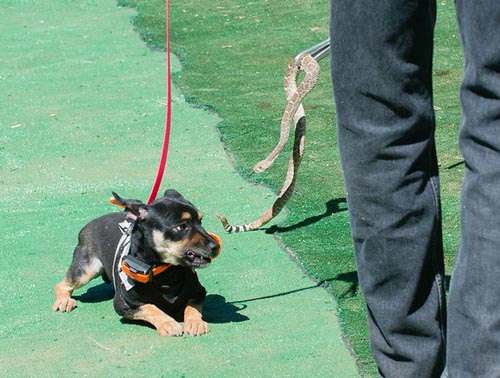
Rattlesnake training a dog
6. Don’t Let Your Dog Eat Plants
Aside from the fact it’s bad for the local flora, your dog could get sick if you allow it to eat plants it finds while hiking.
Some wild plants which are poisonous to dogs include:
- Milkweed
- Hickory nuts
- Horse chestnut
- English laurel
- Mayapple
- Tansy
- Meadow death camas
- Death cap mushroom
- Foxglove
- Lily of the valley
These are just a few of the wild plants poisonous to dogs, so don’t let your dog eat any greenery while hiking!
7. Don’t Use a Retractable Leash while Hiking
Retractable leashes may have their place when walking around town but they should not be used when hiking with your dog. Here’s why:
- The leash is too long. Retractable leashes are up to 26 feet long. At this distance, your dog could get in trouble and you will be too far away to do anything.
- The cord can break. If your dog gets excited, he could easily break the cord and get loose.
- They can cause injury. When the thin cord gets wrapped around something, the friction and pressure can cause burns or even amputations. The cord also often gets tangled with other dogs’ leashes or with bikes.
- The cord can damage trees. If the cord gets wrapped around a tree or other foliage, it can slice into the bark and cause damage.
- They make it hard to control your dog. The thin cord makes it difficult for you to pull your dog back.
- They teach bad habits. Retractable leashes teach your dog to pull on the leash because it will extend it. This results in a dog who constantly pulls at the leash.
Instead, you should hike with your dog on a sturdy leash which is 6 to 8 feet long. For your dog’s safety and comfort, choose one which attaches with a harness instead of a collar.
8. Pack the Right Gear for Your Dog
A lot of human hikers are guilty of not bringing proper gear when hiking because “it’s only going to be a short trip.” This attitude is why day hikers are more likely to need rescuing than backpackers: something happens, like getting lost or injured and having to spend an unplanned night in the wilderness, and they don’t have adequate supplies. Please read this post about what to bring on every hike.
The same attitude also applies to hiking with a dog: you must be prepared. Here are the supplies you’ll need to have on a hike with your dog.
- Collapsible water bowl
- Water: Dogs can also get diseases like giardia, so they shouldn’t drink from water sources. Bring water for them or use a purifier. Large dogs drink about 0.75oz of water per pound of bodyweight per day. Smaller dogs drink about 1.5oz per pound. Bring extra water in hot weather.
- Doggie first aid kit: See this post for what to include in your dog first aid kit.
- Poop bags, carrying case for filled bags, and/or trowel
- Leash: 6 to 8 feet long
- Collar with tag: The tag should include your dog’s name, rabies tag, license, and your phone number.
9. Protect the Paws
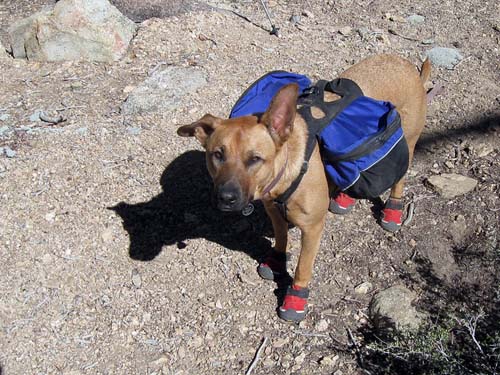
Hiking trails can have lots of jagged rocks, hot rocks, or thorny growth. These can tear your dog’s paws and make it incredibly painful to walk. I’ve heard plenty of stories of people having to carry their dogs for miles off the trail because they had bloody paws.
To protect your dog’s paws while hiking:
- Go slow: If your dog has spent a lot of time indoors, its paws will not be tough. Start with short hikes and work your way up. Your dog’s paws will callus and toughen over time.
- Use hiking booties: If your dog will wear them, these do wonders at keeping the paws safe.
- Paw pad balm or wax: This adds a protective layer to your dog’s paws which can help prevent injury.
- Trim nails: Long nails are more likely to split and tear, which can lead to infection.
- Trim hair between nails: Long paw hair will absorb mud and dirt, causing your dog’s toes to spread uncomfortably.
- Check paws every few hours: Make sure there aren’t any cuts or lacerations on the paw. Apply more paw balm if the paws seem too dry.
10. Don’t Overpack Your Dog’s Backpack
Doggie backpacks are a great way for your dog to carry some of its own gear. How much weight can your dog safely carry? Dogs shouldn’t carry much weight until they have stopped growing, which can be 18 months for some breeds. As a general rule, healthy adult dogs can carry 1/3 of their bodyweight. However, it’s probably better to keep the load to a maximum of 25% of their bodyweight.
11. Learn the Signs of Exhaustion and Overheating
Just because you aren’t tired or hot it doesn’t mean your dog isn’t. Some dogs aren’t able to handle hiking very well. Short-muzzled dogs especially have a hard time in the heat. Small puppies and senior dogs are also susceptible.
Be on the lookout for these signs:
- Fast panting or pulse
- Excessive drooling
- Glazed or sunken eyes
- Vomiting or diarrhea
- Becoming unresponsive
- Muscle tremors
- Dizziness
If you see any of these signs in your dog, it’s time to take a break in a shady spot. Provide small amounts of water to drink; too much water at once actually doesn’t help hydrate. You can also put cool (but not cold) water over your dog’s ears and paws to help them cool down. If this doesn’t seem to help, get your dog to the vet.
Oh, and be prepared to carry your dog out if necessary!
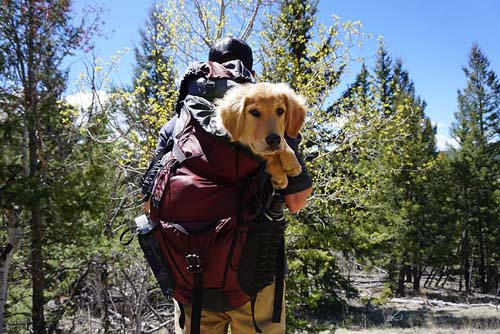
Do you take your dog hiking? Let us know any tips or advice you’d like to add in the comments section below!
Resources:
https://denver.cbslocal.com/2016/11/23/dog-owner-says-lesson-learned-after-encounter-with-mountain-lion/
https://backpackinglight.com/forums/topic/48982/
https://www.outdoorlife.com/8-common-wild-plants-that-are-poisonous-to-your-dog/
https://youdidwhatwithyourweiner.com/washington-northwest-toxic-plants-your-dog-should-avoid/
https://www.trailspace.com/forums/backcountry/topics/56631.html,
https://noahsarkvet.com/11-symptoms-of-heat-exhaustion-in-dogs/
Image credits:
“Bella geared up for the hike down” (CC BY-SA 2.0) by simonov
“Full Tilt” (CC BY 2.0) by Appalachian Encounters
“dog ahead of hikers in Metsäkartano” (CC BY-ND 2.0) by VisitLakeland,
“Rattlesnake Training” (CC BY-NC-ND 2.0) by Dagny Gromer
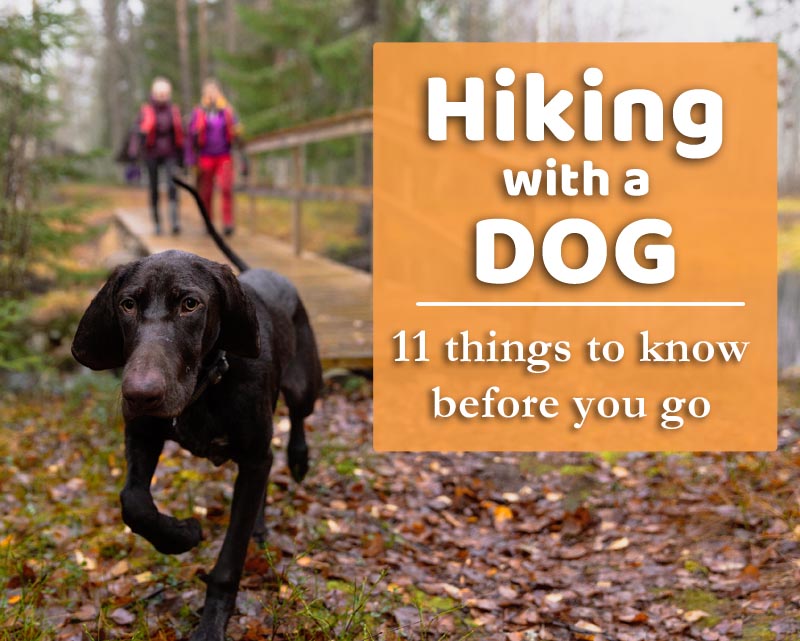


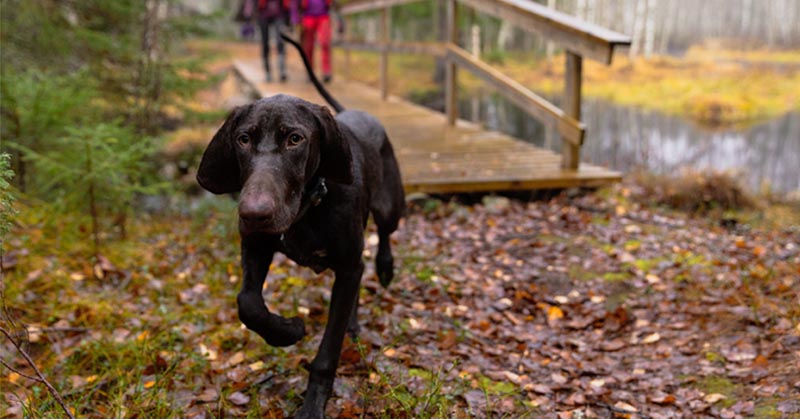
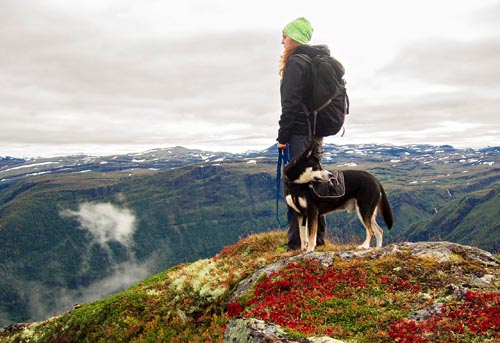
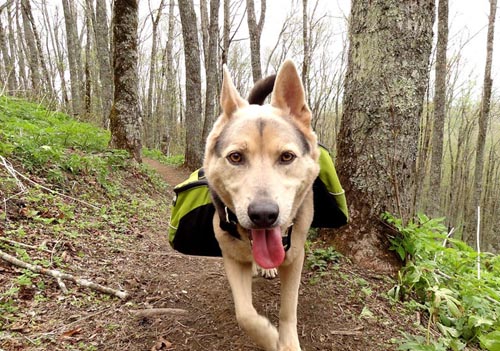
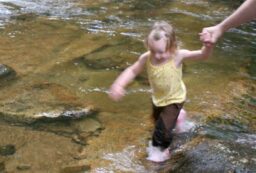

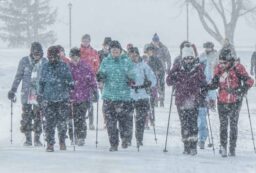







Post your comments